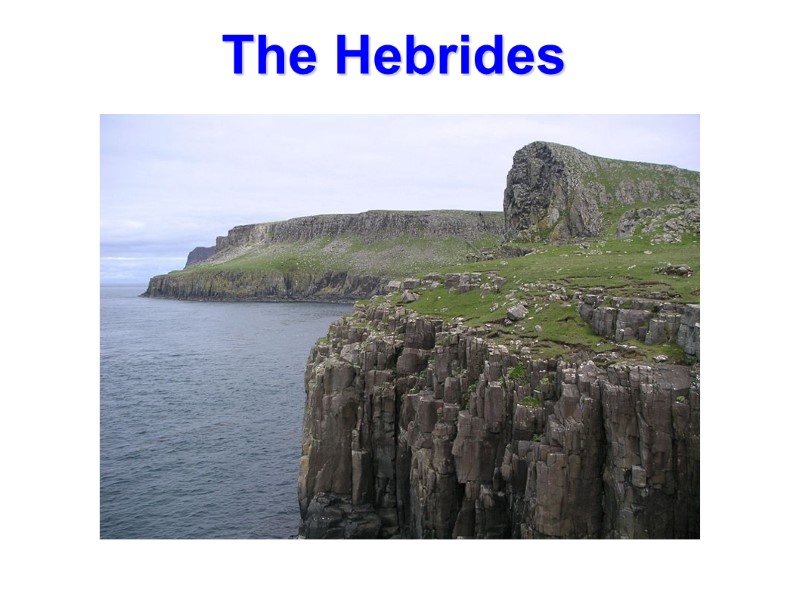The Hebrides Etymology The first reference to a


The Hebrides

Etymology The first reference to a name similar to the modern Hebrides is by Ptolemy, who called the islands Αἱβοῦδαι = Haiboudai in Ancient Greek. Later texts in classical Latin, by writers such as Solinus, use the forms Hebudes and Hæbudes. The old Old Norse name, during the Viking occupation, was Suðreyjar, which means "Southern Isles" . It was given in contradistinction to Norðreyjar, or the "Northern Isles", i. e. Orkney and Shetland. Ironically, given the status of the Western Isles as the last Gàidhlig speaking stronghold in Scotland, the Gaelic language name for the islands - Innse Gall - means "isles of the foreigners" which has roots in the time when they were under Norse occupation and colonisation, and in reference to the Norse-Gaels, known in Gaelic as the Gall-Ghaidhil (meaning Foreign Gaels).

Language The residents of the Hebrides have spoken a variety of different languages during the long period of human occupation. It is assumed that Pictish must once have predominated in the northern Inner Hebrides and Outer Hebrides. The Scottish Gaelic language arrived via Ireland due to the growing influence of the kingdom of Dál Riata from the 6th century onwards and became the dominant language of the southern Hebrides at that time. For a time, the military might of the Gall-Ghàidhils meant that Old Norse was prevalent in the Hebrides and, north of Ardnamurchan, the place names that existed prior to the 9th century have been all but obliterated.The Old Norse name for the Hebrides during the Viking occupation was Suðreyjar, which means "Southern Isles". It was given in contrast to the Norðreyjar, or the "Northern Isles" of Orkney and Shetland. South of Ardnamurchan Gaelic place names are the most common and, after the 13th century, Gaelic became the main language of the entire Hebridean archipelago. The use of Scots and English became prominent in recent times but the Hebrides still contain the largest concentration of Scottish Gaelic speakers in Scotland. This is especially true of the Outer Hebrides, where the majority of people speak the language. The Scottish Gaelic college, Sabhal Mòr Ostaig, is based on Skye and Islay.

The Hebrides comprise a widespread and diverse archipelago off the west coast of Scotland. There are two main groups: the Inner and Outer Hebrides. These islands have a long history of occupation dating back to the Mesolithic and the culture of the residents has been affected by the successive influences of Celtic, Norse and English speaking peoples, which is reflected in the names given to the islands.

The Inner Hebrides is an archipelago off the west coast of Mainland Scotland, to the south east of the Outer Hebrides. Together these two island chains form the Hebrides, which experience a mild oceanic climate. There are 36 inhabited islands and a further 43 uninhabited Inner Hebrides with an area greater than 30 hectares (74 acres). The main commercial activities are tourism, crofting, fishing, and whisky distilling. In modern times the Inner Hebrides have formed part of two separate local government jurisdictions, one to the north and the other to the south. Combined, the islands have an area of approximately 412,850 hectares (1,594 sq mi), and had a population of 18,257 people in 2001. The population density is therefore a little over 4 persons per km2 (11 persons per square mile). The Outer Hebrides also known as the Western Isles and the Long Island, is an island chain off the west coast of mainland Scotland. The islands are geographically coterminous with Comhairle nan Eilean Siar, one of the 32 unitary council areas of Scotland. They form part of the Hebrides, separated from the Scottish mainland and from the Inner Hebrides by the waters of the Minch, the Little Minch and the Sea of the Hebrides. Scottish Gaelic is the predominant spoken language, although in a few areas English speakers form a majority.

11204-the_hebrides.ppt
- Количество слайдов: 6

